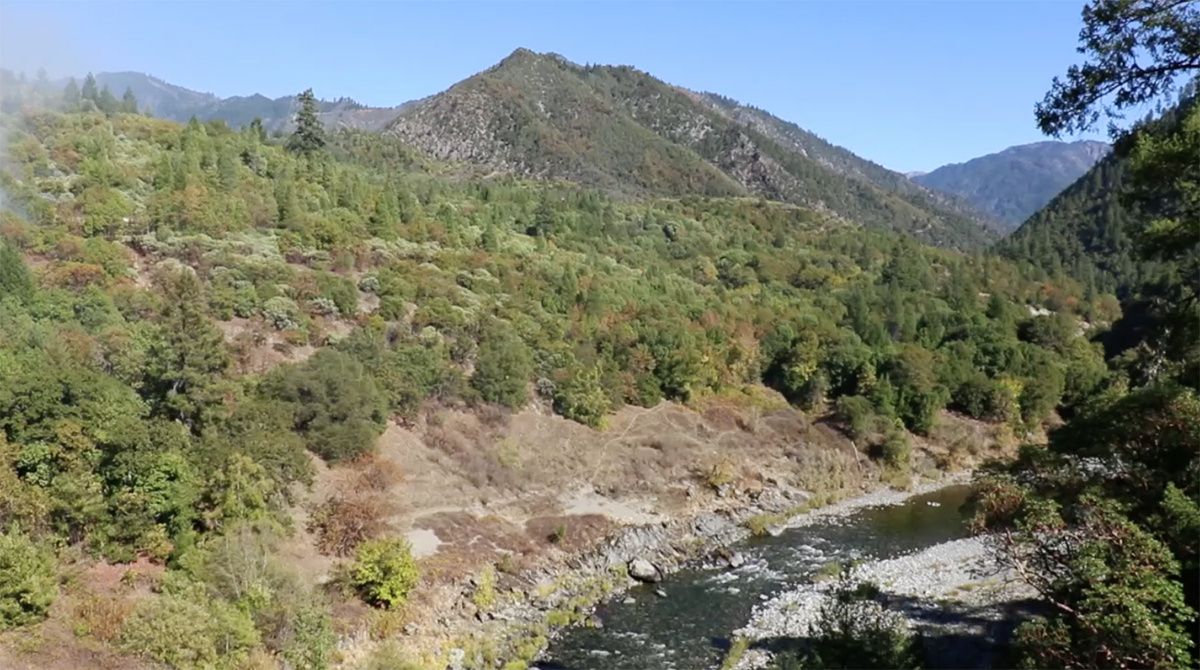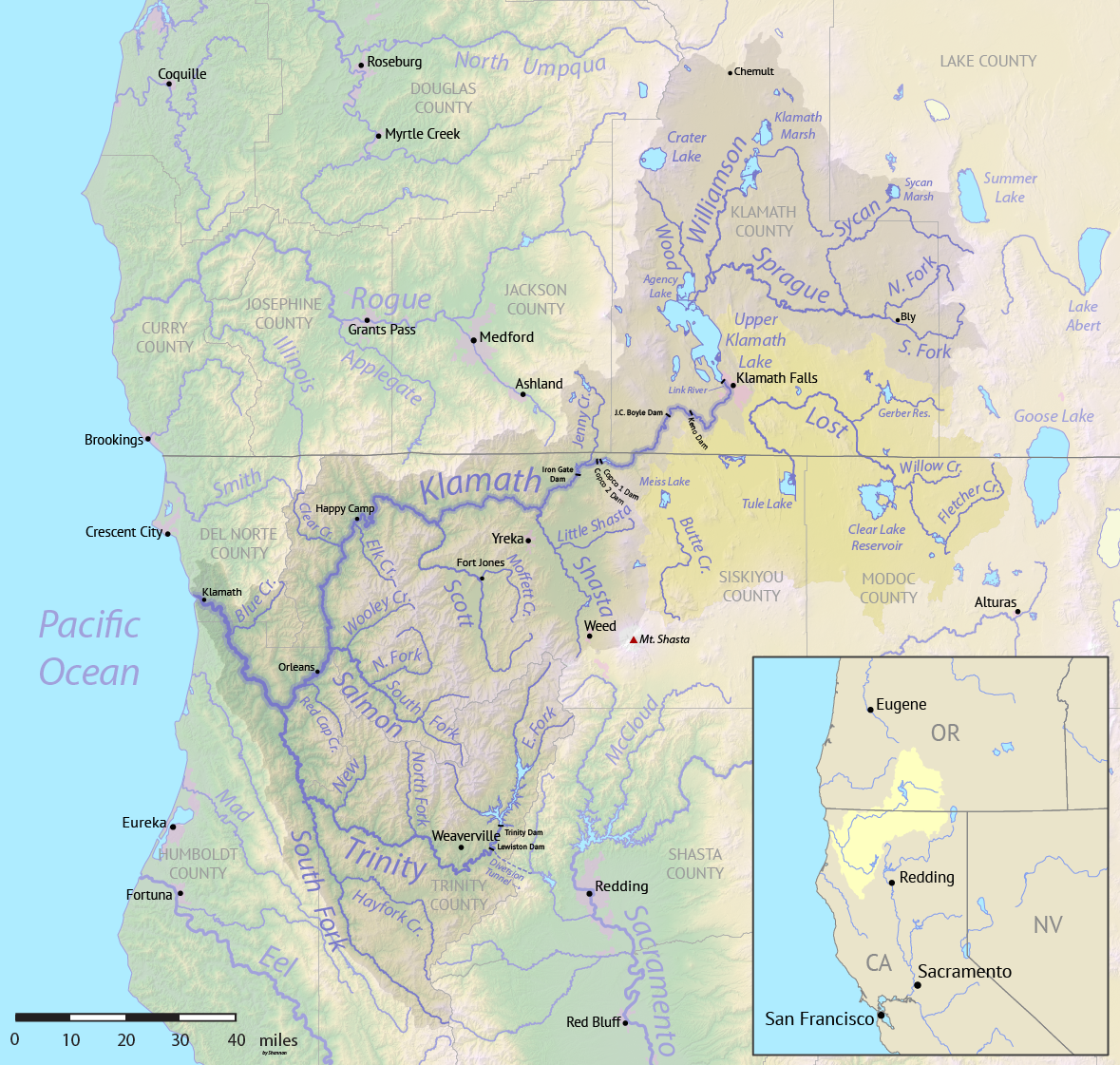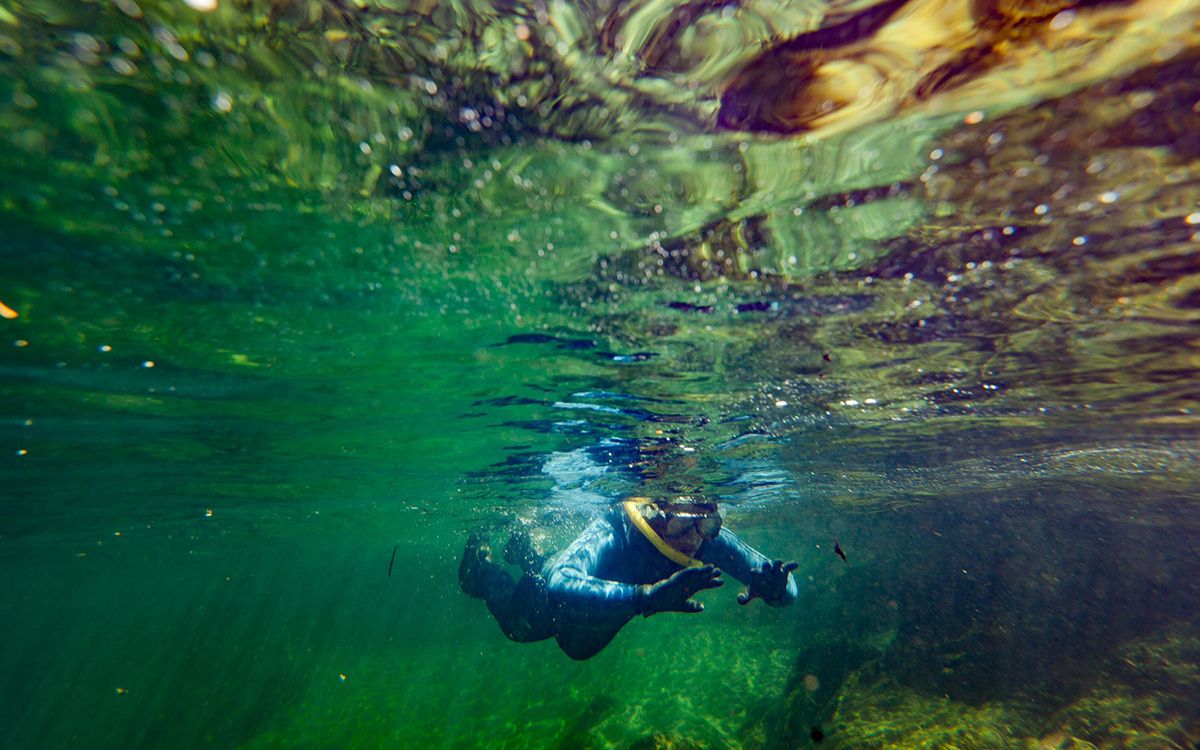

By Heather Smith
To get to the largest surviving population of wild Spring Chinook salmon on the Klamath River, I drive farther north than I’ve ever been in California, then turn right. Gradually, the highways disappear, and the roads narrow. Commerce becomes more improvisational. Grocery stores and restaurants disappear and in their place there is a farm stand staffed by Gandalf in overalls and a naked baby cooing to itself and scooting along on a tricycle.
The roads become more improvisational too, and begin to curve and twist until they nearly double back on themselves, until my rental car is trundling along a single lane of dirt and gravel carved into the edge of a cliff. It becomes clear to me that if I meet another car going in the opposite direction that one of us is going to die, probably me. But when I do round a corner and see another car it does a set of maneuvers that seem to bend space-time, and somehow we pass by each other smoothly, and continue on our way.
My destination is a one-room schoolhouse in Forks of Salmon, CA, a place where the closest thing to a town square is a tree that you sit under to drink beer. During the day, a gang of horses roams parking lots and lawns, looking for dumpsters or unattended coolers to break into.
Inside the schoolhouse, the Forest Service and the Salmon River Restoration Council, a local nonprofit, are checking out swim gear to the 90 or so people who have arrived for the annual Spring Chinook salmon count. Tomorrow, we are going to swim down 75 miles of the Salmon River, counting every Spring Chinook salmon we run across.
Salmon RiverScreengrab from video by Mikal Jakubal
Big changes are coming to the Klamath, which was once Manhattan, for salmon. Local kids from the Yurok and Karuk tribes grow up on stories about how during the old Spring and Fall Chinook runs the water was so thick with fish that you could practically walk across them. In 2020, demolition will begin on four major dams—Iron Gate, John C. Boyle and Copco 1 and 2. It will open up 300 miles of salmon habitat that has been closed off for nearly a hundred years—the largest river restoration project in U.S. history.
The Spring Chinook is the first fish to return from the ocean as the winter comes to an end. It’s hard to overstate its importance to the tribes who live on the Klamath, as a religious symbol, and as a literal means of survival. As time goes on it may prove even more critical, because it may prove more resistant to the effects of climate change than the Fall Chinook because it travels early in the year, when water levels are high and cold. But the Spring Chinook became extinct in many tributaries of the Klamath decades ago: a casualty of dams, agricultural runoff, and water being diverted to farms and orchards as far away as California’s Central Valley. Remove the dams, and it’s possible that the Chinook on the Salmon River could repopulate their former territory.
The Spring Chinook persists on the Salmon because even though gold mining and logging did a number on the local ecology, the river was never dammed or diverted. Its headwaters come out of Marble Mountain wilderness, and the tributary itself is surrounded by forest service land. This is one of the reasons we’re even able to count the salmon in the first place: private landowners often restrict river access, out of fear that letting people collect data will lead to more restrictions in the future.
Map of the Klamath Basin Shannon1
Because the Salmon river is cold, fast, and full of rocks, our goal is to cover as much of our bodies with neoprene as possible. I successfully check out a snorkel, a wetsuit, a sun-faded jacket with a hole in the elbow, neoprene gloves, two funky-smelling neoprene socks with holes in the heels, and shoes that look like regular hiking boots, but which turn out to be underwater hiking boots.
The only thing I’m missing is a cowl, which looks like a neoprene ski mask. There is only one cowl left. It has “Small” written on the side of it in magic marker, and it looks like it would be appropriate for a toddler.
“Do you have any more cowls?” I ask. “My head is really big.” I point to my head, for reference.
The woman supervising the bins looks at me speculatively. “Why don’t you just try it?”
I pull the cowl gently over my head. Then less gently. Then violently. Improbably, it slides into place and breathing suddenly becomes difficult. I claw at my face and dance backwards, like a dog trying to back out of a veterinary cone.
I’m not sure how I get myself out of the cowl but when I do, I am relieved to see that all humans in this room are struggling with their wetsuits in their own special way. Everyone is working out their own technique. Some people hop up and down and yank. Some contort. The overall result, played out across the room, is that of a very energetic modern dance performance.
Any salmon who make it to the Salmon River to spawn will find perfect conditions to reproduce—but that’s if they make it. It’s July 2017, the first summer after the worst drought in California’s recorded history. Last year, the Chinook count was around 398—a fraction of what it had been before the drought, and half the average run over the last 20 years. During the worst of the drought years, the farmers of California’s Central Valley filed court injunctions to block releasing water from dams that was meant to lower water temperatures and save wild salmon. Both the Karuk and the Yurok voluntarily reduced their subsistence and ceremonial fishing this year, in the hopes that the Spring Chinook will recover.
The salmon counters who have come here cut a wide swath across subcultures and archetypes: The Forest Service, Fish & Wildlife, the salmon scientists, the teenager from the local Karuk tribe with the green hair and lip ring, the dive school students from Humboldt State, the back-to-the-land old timers, the documentary filmmaker, the pot entrepreneurs, the real estate agent from a few towns over who keeps bringing the conversation back to nearby homes for sale, and the high school kids working for the Youth Civilian Conservation Corps. The high school kids have perfect California teen names: Trinity, Cassidy, Reno, Chainsaw (Chainsaw is thrilled to be monitoring salmon this summer, since he spent the last one cleaning park toilets). There’s the guy in a utilikilt, another guy who describes himself as a “salmon groupie,” and the woman with a crystal pendant dangling in the middle of her forehead.
They’re drawn here for different reasons. Some people have traveled in from nearby towns just for the opportunity to socialize. “I’m here for the free camping and free food,” says one of the Humboldt State students, adding that it’s easier to dive here right now than in Arcata Bay, where the fertilizer runoff from local weed farms trickles down to meet the ocean. “I felt the call of the salmon and the oceans last May,” says the woman with the crystal, and leaves it at that.
Salmon counter underwaterMikal Jakubal
Once we have all assembled more or less complete wetsuit setups, we trudge down to a nearby pond to practice the defensive maneuvers we’re supposed to do if we encounter some rapids (roll on your back, use your feet to push yourself away from rocks before the rocks slam into you, never try to stand up because if your foot gets caught, the river can push you underwater and drown you in no time flat). If we get swept downstream, the instructions are to hike to the nearest house and ask to use their phone. There’s no cell reception out here, and anyone living nearby knows all about the salmon count.
The next morning, we split into groups that are each assigned a section of the river. Out of the water, we trudge over boulders, with the Klamath National Forest stretching around us in all directions. Underwater, the world is cold and alien. One minute, the river bottom is gravel, just a few inches away from the mask of my snorkel, and then the next, the river bed falls away and I’m floating over an inky expanse that seems to have no bottom. There’s no mistaking that this is earthquake country. There’s also no mistaking that this underwater world is empty. One of the most experienced divers in our group sees two tiny salmon, the rest of us see none. It’s an eerie feeling—like wandering through a beautiful house that is mysteriously vacant.
Navigating our section of the river is not easy. Where the river narrows, the stream is violently fast, and we crawl out onto the boulders at the edge of the streambed and hike for a long time in our soggy frogman getups. A few times I underestimate how fast the current is, and find myself pinging from rock to rock, like I’m in a live-action pinball machine.
During these times, I find myself wishing I was a little bit more like a salmon—flexible, without so many extremities. Later, I find out that this is a rough environment for salmon too. Before the late 1800s, when gold was discovered on the Salmon River, the river was much wider, and moved more slowly. When gold miners arrived they washed away the cliffs with high pressure hoses, and filled the river valley with rubble, leaving a fast, narrow channel. Juvenile fish will get banged up on the rocks or flushed out into the Klamath, where they’re done in by parasites and bacteria from agricultural runoff. For that reason, there’s a whole division of salmon habitat restoration that just involves slowing rivers down by re-creating creeks and floodplains that were filled in or blocked off by mining. Even before a floodplain is completely restored, often a troupe of beavers will show up and finish the job.
Salmon counters Mikal Jakubal
When I see the orange ribbon that marks the end of our section of the river, I relax and float. This turns out to be one of the worst ideas I’ve ever had, because what looks like a flat glassy pool at the end pours into a section of rapids that was deemed too dangerous for the group to navigate.
I go over a waterfall. It’s only a few feet high, but it’s fast, and I’m out of my league. It’s a dreamlike sensation to completely lose control of your body. The water swings me into a boulder, and as my head hits the rock the sound is like someone has rung a bell that also happens to be me. I try to remember what I was supposed to do to not die in this situation, and then I pass a rock big enough to grab with both arms. I drag myself on top of it and lie there, scared to move any more. The rest of the group, which has been screaming and running along the shoreline, catches up to me. “That was great!” says the group leader. “You did that exactly right!” I am torn. I would like to believe that I am great, and I did do that exactly right. As a former child care professional I know that this phrasing is the exact same tactic that people use on kids when they’ve hurt themselves, and don’t want them to start crying.
Back at the schoolhouse, we eat pasta dinner. The old timers reminisce about how, before the numbers dropped so severely, the salmon count used to conclude with Spring Chinook purchased from the Yurok, and cooked the way that it was in this area for thousands of years, which is skewered like kebabs and smoked around an open fire. The Spring Chinook is fattier than salmon that migrates later in the year, so it’s perfect for this type of cooking, and when I ask people what it tastes like, they just look off into the distance and say, wistfully, “It’s the best fish you’ll ever have.”
When I wake up the next morning and can’t hear out of one ear, I will sit down on a rock and allow myself a moment of perfect sadness at the possibility of having lost 50 percent of my hearing to something so basic and boring as a boulder. The sadness will prove unnecessary—as it turns out, the absence of sound is just swelling from a perforated eardrum, plus an infection from the river water that we were warned so sternly not to drink. After a few weeks of having to rotate my head so that my good ear is facing whoever I’m talking to, it’s like the boulder never happened.
That evening we learn that the recorded count this year is 110—just a little under the all-time low of 90, back in 2005, and a far cry from the highest recorded count of 1593 back in 2012. At a conference the next day, the tone is somber. “When I heard last night the number of salmon in the system it was like a kick to the gut,” says Josh Saxon of the Karuk Council. “We are failing this species. If this disappears so will our ceremonies.”
“These fish are our relations. I don’t take that lightly.” says Will Harling, Director of the Mid Klamath Watershed Council. “Whether or not you subscribe to God or world renewal, this is about survival and place. That’s why we got to keep the fish here. We as humans—we are the problem. But we’re also the solution.”
Later, after numbers come in from Wooly Creek, that count is raised to 160, which is still dangerously low. “This year we had perfect conditions,” says Karuna Greenberg, Restoration Director for the Salmon River Restoration Council. “The river was perfect, all summer long. The eggs would have grown up on the river under really good conditions. The rearing conditions would have been good. The fish would have been unlikely to get diseases. If we even had 350 or 400 fish …”
But for the moment, salmon alarm can wait. Back where the salmon counters are camping, there’s a bonfire. The Humboldt State students are playing card games with a deck made of cards depicting California wildflowers, and scheming about how to sneak into a scientific symposium tomorrow. The group playing guitars around the fire has tripled in size, and now, improbably, includes an upright bass. The haze from the Island Fire has cleared temporarily and the sky is full of stars.
Out of the corner of my eye I see one star drop casually, like a swimmer leaping off a high dive. Then I see another, and another. Even though I’d forgotten about it, the Aquarid meteor shower kept going about its business and happened anyway. That’s why I’m here really—probably why we’re all here. Even more intoxicating than the idea of a nature that needs protecting is the idea of nature so wild that it doesn’t need us at all to survive. I look up, and another star falls.
Reposted with permission from our media associate SIERRA magazine.

 233k
233k  41k
41k  Subscribe
Subscribe 



